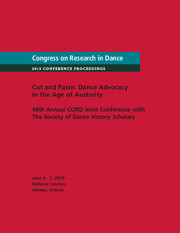Article contents
Recreating the Eye of the Beholder: Dancing and Spectacular Display in Early Modern English Theatre
Published online by Cambridge University Press: 04 April 2012
Abstract
Shakespeare and his contemporaries regularly staged plays that exhibited feats of physical prowess, such as dancing, acrobatics, and combat. Spectacles of this sort existed in a kind of double space: even as they operated within a play's fictional narrative, they also served as legitimate entertainments in their own right. Jean Alter refers to these complementary aspects of theatre as its “referential” and “performant” functions: theatre as semiotic system, employing both mimetic and nonmimetic forms of representation, and theatre as spectacular show, akin to sports or the circus. My paper analyzes the interplay between these two performance modes in displays of bodily skill in the early modern English theatres. Drawing on a variety of sixteenth- and seventeenth-century documents concerning foreign travel, sensory perception, physical talent, and popular festivity, I explore the cultural valences of what contemporaries referred to as “feats of activity” that refreshed, or “recreated,” the eye. I pay particular attention to onstage dances. These episodes, I contend, suggest an alternative to post-Benjamin, post-Brecht notions of spectacle as that which dazzles passive viewers. Juxtaposing extratheatrical primary sources with brief snapshots from Christopher Marlowe's Doctor Faustus, I reconstruct the historically specific affective experiences generated by early modern displays of physical spectacle. Nonverbal practices, such as dance, were not merely depicted in drama but integrated into the performance medium itself. I argue that the resulting dynamics between representation and presentation situated spectators as active participants in the performance event. In this way, onstage dances reinforced communal identity and contributed to the construction and dissemination of broader cultural discourses.
- Type
- Research Article
- Information
- Copyright
- Copyright © Erika T. Lin 2010
References
Works Cited
- 1
- Cited by


